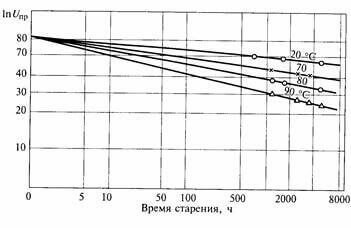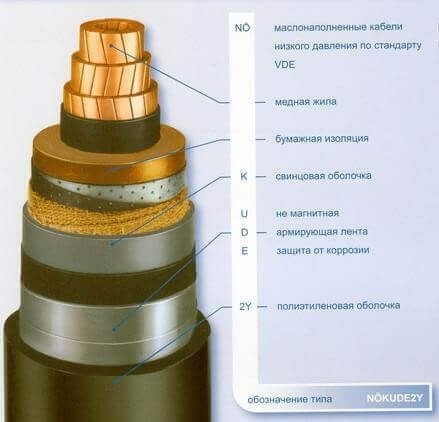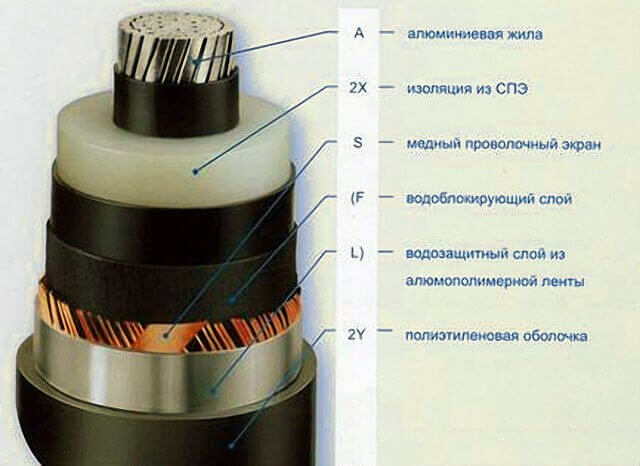Content:
- Physical sense
- Breakdown types
- Gas and insulation
- Reasons for the decrease in dielectric strength
- Electrical strength of power cables
Physical sense
The electric field strength increases with increasing voltage between the conductors, it can be capacitor plates or cable cores (in an individual winding), at a certain moment a breakdown occurs isolation. The value characterizing the voltage at the moment of breakdown is called the dielectric strength and is determined by the formula:

here: U - voltage between conductors, d - dielectric thickness.
Dielectric strength is measured in kV / mm (kV / cm). This formula is valid for flat conductors (in the form of strips or plates) with an even layer of insulation between them, such as in a paper capacitor.
 Short circuits in electrical devices and cables occur precisely because of the breakdown of insulation, at this moment there is electric arc. Therefore, dielectric strength is one of the most important characteristics of insulation. Requirements for the dielectric strength of the insulation of electrical equipment and electrical installations voltage 1 - 750 kV are set out in GOST 55195-2012 and GOST 55192-2012 (test methods for dielectric strength at the installation site).
Short circuits in electrical devices and cables occur precisely because of the breakdown of insulation, at this moment there is electric arc. Therefore, dielectric strength is one of the most important characteristics of insulation. Requirements for the dielectric strength of the insulation of electrical equipment and electrical installations voltage 1 - 750 kV are set out in GOST 55195-2012 and GOST 55192-2012 (test methods for dielectric strength at the installation site).
Breakdown types
For homogeneous dielectrics, several types of breakdown are distinguished - electric and thermal. There is also another ionization breakdown, which is a consequence of the ionization of gas inclusions in a solid dielectric. The dielectric strength of dielectrics, in many respects, depends on the inhomogeneity of the field and the occurrence of gas ionization processes (intensity and nature) or other chemical changes in the material. This leads to the fact that breakdown in the same material occurs at different voltages. Therefore, the breakdown voltage is determined by the average value based on the results of numerous tests. The dependence of the dielectric strength of the gas on the density (pressure) and the thickness of the gas layer is expressed by Paschen's law: UNS= f (pA)

Gas and insulation
It would seem, how is the ionization of gases and the insulation of electrical equipment related? Gas and electricity are closely related, because it is an excellent dielectric. And therefore, a gaseous medium is used to isolate high-voltage equipment.
As a dielectric used: air, nitrogen and SF6. SF6 gas is sulfur hexafluoride, the most promising material in terms of electrical insulation. For the distribution and reception of high voltage electricity, more than 100 kV (power plant outlet, reception electricity in large cities and so on), complete switchgears are used (GIS).
The main field of application of SF6 gas is precisely GIS. Gas, in addition to being used as electrical insulation, can arise during the operation of oil-filled cables (or cables with impregnated paper insulation). Since there is a cyclic heating and cooling of the cable as a result of the passage of voltages of different magnitudes.
For cables with impregnated paper insulation, the term "thermal destruction" is applied. Pyrolysis of cellulose produces hydrogen, methane, carbon dioxide and carbon monoxide. During the aging process of the insulation, the resulting gas formations (at increased voltage) cause ionization breakdown of the insulation. Due to ionization phenomena, power cables with oil-impregnated paper insulation (viscous impregnation) are used in power lines with voltage up to 35 kV and are less and less used in modern energy.
Reasons for the decrease in dielectric strength
The most negative influence on the dielectric strength of the insulation is exerted by alternating voltage and temperature. With an alternating voltage, that is, a voltage that changes from time to time, for example, the power plant outputs 220 kV, due to a technical malfunction or planned repair, the voltage value was reduced to 110 kV, after the repair it became 220 again kV. This is an alternating voltage, that is, changing over a certain period of time. Due to the fact that in the Russian Federation 50 percent of electrical installations for the transmission of electricity are already have exhausted their resource (and it is 25-30 years), then the alternating voltage is quite frequent phenomenon. The average value of this voltage is determined using the graph:
 Or determined by the formula:
Or determined by the formula:
 The heating temperature of the cable, due to the flow of electric current, significantly reduces the service life of the conductor (the so-called aging of the insulation occurs). The dependence of the breakdown strength at different temperatures is shown in the graph:
The heating temperature of the cable, due to the flow of electric current, significantly reduces the service life of the conductor (the so-called aging of the insulation occurs). The dependence of the breakdown strength at different temperatures is shown in the graph:

Electrical strength of power cables
The most demanding branch of production in terms of dielectric strength is probably cable products. In Russia, the main type of cables used in the power industry (designed for rated voltage up to 500 kV) are oil-filled cables with paper insulation.
Moreover, the higher the rated voltage for which they are designed, the higher the weight of the cable. Degassed and low-viscosity oil (MH-3, MH-4 and analogues) is used as an impregnation. An increase in oil pressure leads to an increase in the dielectric strength of the oil and paper insulation. Cables with a pressure of 10-15 atmospheres are used at high tension, the strength value reaches 15 kV / mm.

In recent years, oil-filled cables have been replaced by XLPE cables. They are lighter, easier to operate, and the service life is the same. In addition, PSEs are not so sensitive to temperature changes and do not need additional equipment, such as oil compensating tanks (to compensate for excess oil at different pressures). XLPE cables are easier to install and easier to maintain and maintain.

The whole world is developing specifically XLPE cables, this has led to the fact that such conductors are already noticeably better in their parameters than oil-filled cables:
 The only drawback of PPE is intensive aging, however, numerous studies of all world manufacturers have slowed down this process. The so-called treeings are no longer the reasons for insulation breakdown. The growth of energy consumption in the modern world stimulates the development of not only power sources, but also cable products and switchgears. Research on the dielectric strength of insulation is the main focus in power energy.
The only drawback of PPE is intensive aging, however, numerous studies of all world manufacturers have slowed down this process. The so-called treeings are no longer the reasons for insulation breakdown. The growth of energy consumption in the modern world stimulates the development of not only power sources, but also cable products and switchgears. Research on the dielectric strength of insulation is the main focus in power energy.
Related materials:
- Protection of the cable from mechanical damage
- Measurement of cable insulation resistance
- Causes of power loss over long distances

